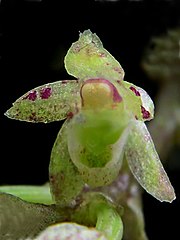Drymoanthus
 Drymoanthus adversus | |||
| Systematyka[1][2] | |||
| Domena | |||
|---|---|---|---|
| Królestwo | |||
| Podkrólestwo | |||
| Nadgromada | |||
| Gromada | |||
| Podgromada | |||
| Nadklasa | |||
| Klasa | |||
| Nadrząd | |||
| Rząd | |||
| Rodzina | |||
| Podrodzina | |||
| Rodzaj |
Drymoanthus | ||
| Nazwa systematyczna | |||
| Drymoanthus Nicholls Victorian Naturalist; Journal and Magazine of the Field naturalist's Club of Victoria 59: 173. 1943[3] | |||
| Typ nomenklatoryczny | |||
|
D. minutus Nicholls[3] | |||
| Synonimy | |||
|
| |||
Drymoanthus – rodzaj roślin z rodziny storczykowatych (Orchidaceae). Obejmuje cztery gatunki występujące w Nowej Kaledonii, Nowej Zelandii (w tym na Wyspach Chatham) oraz w stanie Queensland w Australii. Są to epifityczne, rzadziej litofityczne, rośliny zielne rosnące w lasach na wysokościach do około 880 m n.p.m.[4]
Morfologia
Systematyka
Rodzaj sklasyfikowany do podplemienia Aeridinae w plemieniu Vandeae, podrodzina epidendronowe (Epidendroideae), rodzina storczykowate (Orchidaceae), rząd szparagowce (Asparagales) w obrębie roślin jednoliściennych[4][6][7].
- Drymoanthus adversus (Hook.f.) Dockrill
- Drymoanthus flavus St.George & Molloy
- Drymoanthus minimus (Schltr.) Garay
- Drymoanthus minutus Nicholls
Przypisy
- ↑ Michael A. Ruggiero i inni, A Higher Level Classification of All Living Organisms, „PLOS One”, 10 (4), 2015, art. nr e0119248, DOI: 10.1371/journal.pone.0119248, PMID: 25923521, PMCID: PMC4418965 [dostęp 2022-03-23] (ang.).
- ↑ Peter F. Stevens, Angiosperm Phylogeny Website, Missouri Botanical Garden, 2001– [dostęp 2022-03-23] (ang.).
- ↑ a b Index Nominum Genericorum (ING). Smithsonian Institution. [dostęp 2022-03-23].
- ↑ a b c d e Drymoanthus. [w:] Plants of the World online [on-line]. Kew Royal Botanic Gardens. [dostęp 2022-03-23].
- ↑ a b Drymoanthus. [w:] The World Checklist of Vascular Plants [on-line]. Catalogue of Life Checklist. [dostęp 2023-06-13].
- ↑ Drymoanthus. Tropicos.org. [dostęp 2022-03-23].
- ↑ Drymoanthus. National Center for Biotechnology Information. [dostęp 2023-06-13].
Identyfikatory zewnętrzne (takson):
